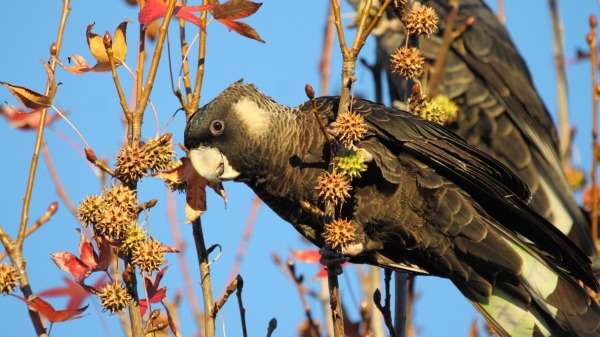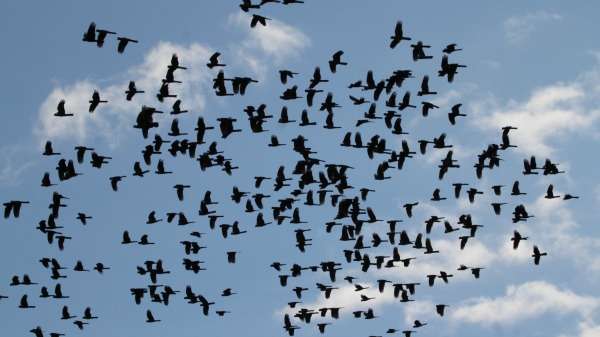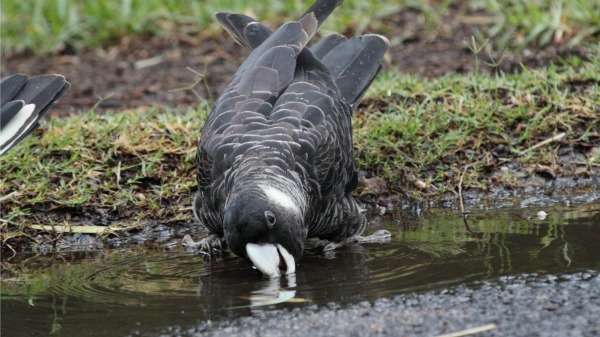A tagged Carnaby feeding in a liquidamber tree. Credit: Christine Groom
For those of us who have grown up in WA, a black cloud comprised of hundreds of cockatoos moving across the sky used to be a common sight.
Their high-pitched vocal call heralded their movement. Nowadays the size of the flocks has decreased, the black cloud has got smaller, the collective cockatoo call is not as loud.
Perth Zoo treats more than 200 injured black cockatoos a year and the numbers are increasing annually.
They are brought to the zoo suffering injuries from vehicle strike or after being illegally shot, or the effects of disease or malnutrition.
The zoo treats the birds, often involving complicated surgery to fix fractures and then works with rehabilitation centres specialising in the care of black cockatoos to release as many birds back to the wild as possible.
But rehabilitating injured birds can be a long intensive process, usually taking months if not years to get the birds back to the required full health and strength to survive in the wild.
But do they survive? Is the intensive work worth the effort? Can the birds reintegrate back into wild life?
In order to unravel this mystery and discover more about the highly mobile species, scientists soared to new heights, attaching satellite transmitters to endangered Carnaby's Cockatoos before their release to the wild.
A flock of Carnaby's cockatoos. Credit: Christine Groom
The research project which was led by then PhD student, Christine Groom, was a collaborative project between Perth Zoo, the University of Western Australia and the Department of Parks and Wildlife WA.
The study involved using light-weight ARGOS satellite transmitters attached to the cockatoos two central tail feathers enabling the researchers to monitor the bird's movements.
"By following flocks as they left or returned to their night roost, it enabled us to show that the rescued birds behaved in a similar manner to wild birds," Dr Groom says.
"It was exciting to see that they flew, roosted, socialised and foraged with wild birds.
"Importantly, we saw that the birds are also able to behaviourally adapt to new environments, so it opens up the possibility of being able to release rehabilitated birds into areas where we know wild populations are struggling and could benefit from extra flock mates or new partners."
The study also provided invaluable information into the travel capabilities of the species.
A Carnaby's cockatoo drinking water. Credit: Christine Groom
"One bird flew 224km from its release site in less than two months, although the majority stayed within the greater Perth region," Dr Groom says.
"But the birds were not just travelling aimlessly. They made distinct changes in their flight paths responding to seasonal changes in food availability and coinciding with migration towards breeding grounds outside the metropolitan area—they certainly had an idea of where they were going.
"The research has unlocked some of the secrets of this highly mobile species and it's hoped will help us develop better strategies to protect them in the future."
Carnaby's Cockatoo is endemic to south-west WA, with its range extending from the Murchison River to Esperance, and inland to Coorow, Kellerberrin and Lake Cronin.
They are listed as endangered due to habitat destruction, loss of nesting hollows, scarce native food sources and many are also struck by cars or illegally shot.
For more information about Perth Zoo's involvement in cockatoo rehabilitation visit their conservation medicine page.
Provided by Science Network WA
This article first appeared on ScienceNetwork Western Australia a science news website based at Scitech.

























